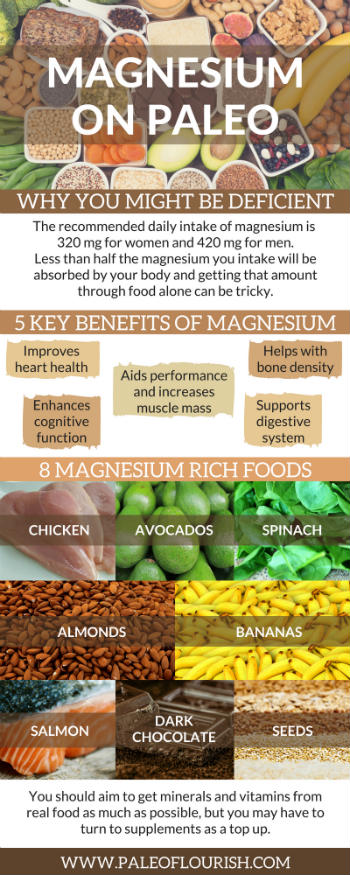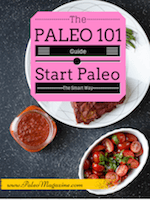Magnesium on Paleo: Why You’re Deficient
If you’re just shifting to a Paleo diet, you might think eating healthy, natural foods elevates you from all health concerns.
How about the levels of magnesium in your body, though?
It can be a big adjustment parting ways with grains and dialing in a diet of whole unprocessed foods, so it’s only natural that a mineral like magnesium might slip under the radar.
In fact, about 75% of Americans are not getting enough magnesium. (1)
A lack of magnesium is tough to spot and diagnose and can have surprisingly wide-ranging consequences. We’ll look today at why this mineral is so important and how you can make sure you get enough of it through food and supplementation.
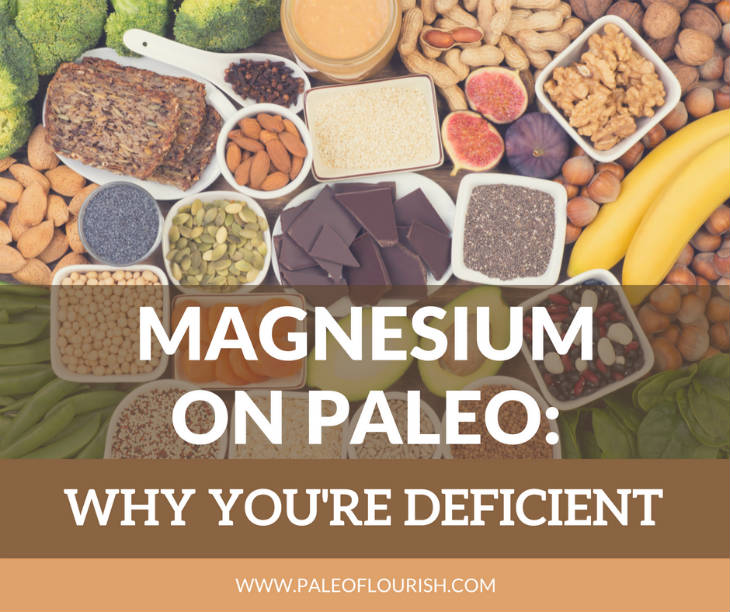
5 Key Benefits of Magnesium
It’s important to keep your intake topped up because your body typically absorbs no more than 40% of the magnesium you consume. (2)
This is bad news because magnesium plays a part in over 300 biochemical reactions in your body, and it’s involved in an array of functions including energy production, bone health, and blood pressure regulation. (3)
Let’s take a look at some of the ways magnesium plays a critical role in the body.
1) Improves Heart Health
If you’re suffering from high blood pressure, magnesium can help to regulate it. (4)
A 2007 study pointed to an association between increased magnesium intake and a healthy heart rate, blood sugar balance, and cholesterol level. (5) Magnesium can also help lower insulin resistance, even helping to combat type-2 diabetes. (6)
Also, by promoting an even heart rate and supporting the process of calcium absorption, magnesium supports your heart across the board.
2) Enhances Cognitive Function
There are several important ways in which magnesium benefits your brain.
Some research suggests that magnesium can alleviate migraines (7) and that perhaps difficulties with absorbing magnesium are at the root of migraines in the first place. (8)
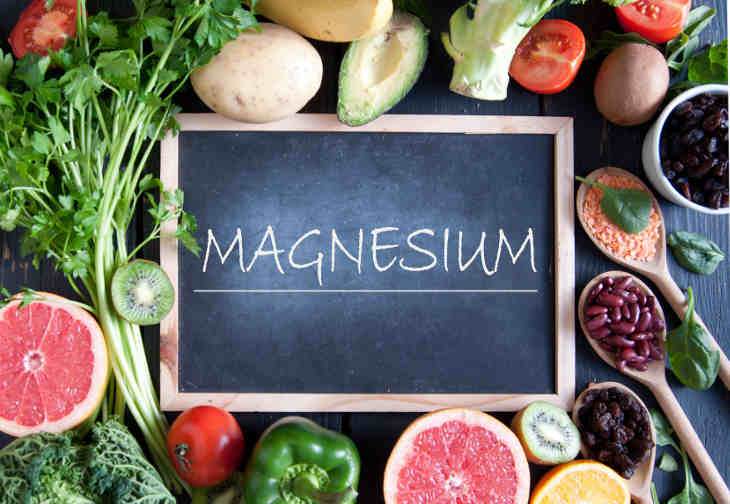
Although more research is needed in the area, one study indicated that magnesium could be beneficial in lifting your mood and alleviating depression. (9)
Optimizing your magnesium levels can help with learning and memory (10) while also making it easier to relax and sleep at night. (11)
3) Supports Your Digestive System
Proper levels of magnesium can help to ward off bouts of constipation that wreak havoc with your digestive system. Magnesium relaxes the walls of the intestines and pulls water into the digestive tract, helping to promote healthy bowel function.
Getting enough magnesium has been found to reduce inflammation and enhance overall intestinal health. (12)
4) Helps With Bone Density
A 1999 study shows a link between increased magnesium intake and superior bone density in older people. (13)
The same was demonstrated in reverse, with lower bone density associated with low levels of magnesium. (14)
So, if you’re advancing in years and concerned about your bone health, it’s critical to get the right amount of magnesium through your diet and any necessary supplementation.
5) Aids Performance and Increases Muscle Mass
A recent study demonstrated the positive role of magnesium in skeletal muscle power and showed how the mineral can help you maintain muscle mass. (15)
Another study found an increase in physical performance following a course of magnesium supplementation. (16)
Why You Might Be Deficient in Magnesium on Paleo
With such a high proportion of people lacking in magnesium, it’s not that the Paleo diet leads directly to this mineral deficiency.
The simple fact is, whatever eating plan you follow, there’s a 3 in 4 chance you need to get more magnesium into your system.
So why is it so tough to keep your magnesium levels in check?
Firstly, less than half the magnesium you take on board will be absorbed by your body. (17)
The recommended daily intake (RDA) for magnesium is pretty high. Women should aim for 320 mg of magnesium a day as a minimum while men should consume at least 420 mg.
When you consider that the magnesium-rich foods in our list below contain just 25 mg to 80 mg of Mg per serving, you can see why it’s challenging to keep your body topped off with enough through diet alone.
While you might want to consider magnesium supplementation, we’ll look now at 8 ways you can eat Paleo-friendly foods that are also dense in this all-important mineral.

8 Real Foods High in Magnesium
Your prime focus should always be getting as many of the nutrients you need from whole, natural foods.
Luckily, you’ve got no shortage of real magnesium-dense foods at your disposal.
Although many grains, soy products, and cereal are fortified with magnesium, there are more than enough Paleo-friendly options as well: (18)
- Almonds: Topping the list of magnesium-packed foods, a single serving of almonds has a solid 80 mg of magnesium, 20% of your daily magnesium in one hit.
- Avocados: You can get another 11% of your magnesium in a 1-cup serving of cubed avocado. With plenty of potassium, fiber, and healthy fats, avocado works brilliantly with the Paleo diet.
- Spinach: As with other leafy greens, you’ll get about 20% of the magnesium you need in a half cup (cooked).
- Chicken: Roasted chicken breasts are a great way to get in another 22 mg of magnesium in one 3-oz serving.
- Bananas: Snack on a medium banana and you’ll get 32 mg of magnesium, 9% of your RDA in just minutes. Bonus: Unripe (green) bananas can also lower blood sugar and improve gut health. (19)
- Dark Chocolate: Although not strictly Paleo, if your interpretation of the diet allows for the occasional nibble of 70-85% dark chocolate, you’ll get 17% of your daily magnesium intake in just 1 oz. (20)
- Salmon: You should eat plenty of fatty fish, and a fillet of wild-caught salmon provides 14% of the magnesium you need. (21)
- Seeds: A occasional indulgence in a handful of seeds is a quick route to ensuring you don’t suffer from magnesium deficiency. Pumpkin seeds can provide 37% of your daily mag per ounce. (22)
Even if you eat plenty of the foods listed above, you might still find your magnesium levels are low. Unfortunately, other factors can impact the amount of magnesium absorbed by your body.
Certain foods, drinks, medications and supplements can interfere with magnesium absorption, (23) making it even harder to get adequate amounts of the mineral. Calcium and phosphorus, for example, can impair absorption of magnesium. (24)(25)
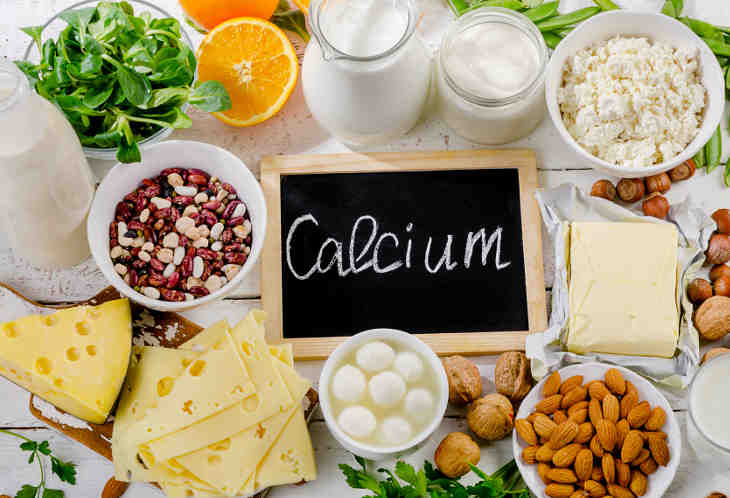
Given the number of ways in which your magnesium levels might be affected, it makes sense to consider a supplement.
Best Magnesium Supplement To Use
The supplement market is glutted so we’re here to save you time…
Taking this magnesium supplement is an inexpensive and highly effective way to make sure you keep your magnesium levels ratcheted up without needing to eat 10 avocados a day.
Which Type of Magnesium is Most Bioavailable?
“Bioavailability” is the degree to which a substance actually enters your bloodstream so that the body can actively use it.
When it comes to magnesium supplements, there are many types, and they vary considerably when it comes to bioavailability and benefits. Chelated supplements, like the one we recommend, are easy for the body to absorb and utilize.
Among the chelated magnesium supplements, magnesium glycinate is one of the most bioavailable forms (26) and is more gentle on the GI tract than some of the others.
Another way to get more of this powerful nutrient is to use transdermal magnesium, perhaps in the form of an oil or lotion, or epsom salts that are added to the bath.
Transdermal magnesium is absorbed through the skin, bypassing the digestive tract altogether. This has been shown to be a fast-acting and effective way to increase magnesium in the body. (27)
Concluding Thoughts
You should aim to get minerals and vitamins from real food as much as possible.
Even if you do your best, though, and eat a perfect Paleo diet, you might still be deficient in magnesium, so it’s really worth using a supplement as well.
Pinterest Image For Magnesium on Paleo: Why You’re Deficient
Please pin the image below so that you and others can quickly and easily refer to the list and find out why you might be in need of a magnesium boost!
